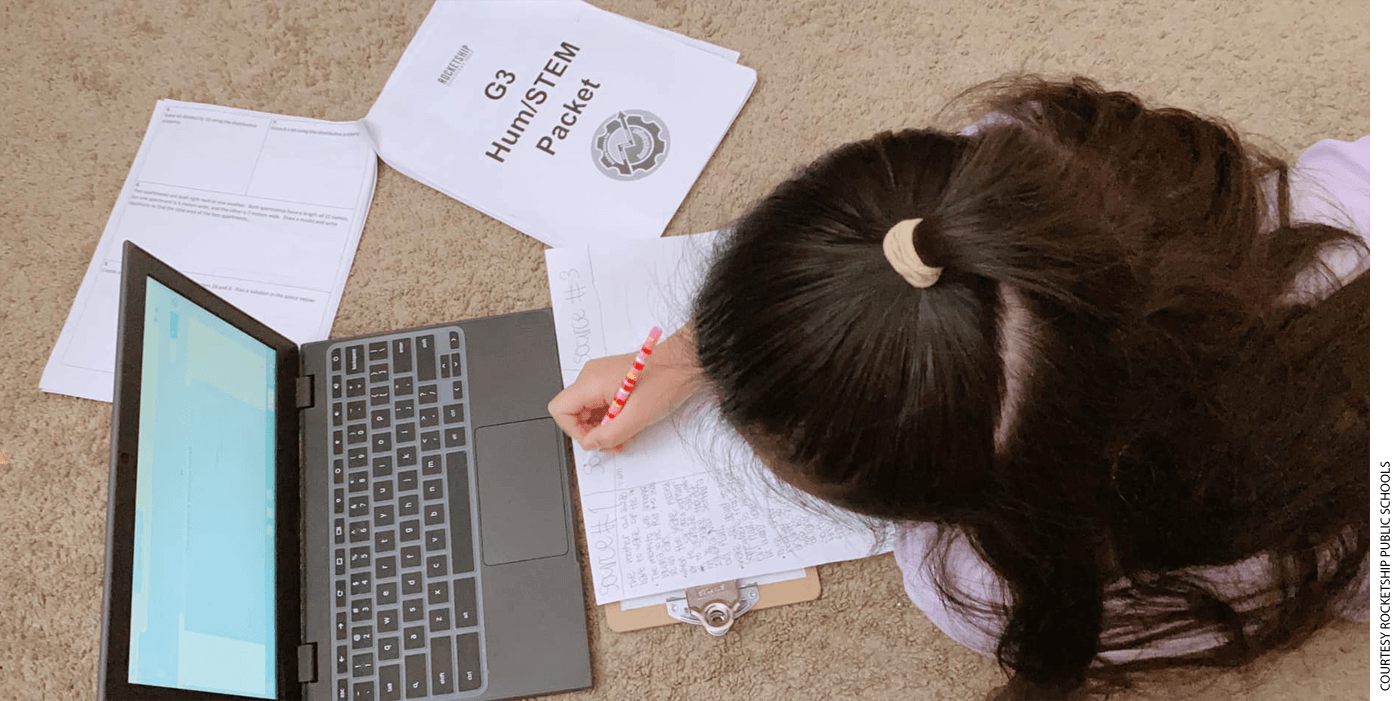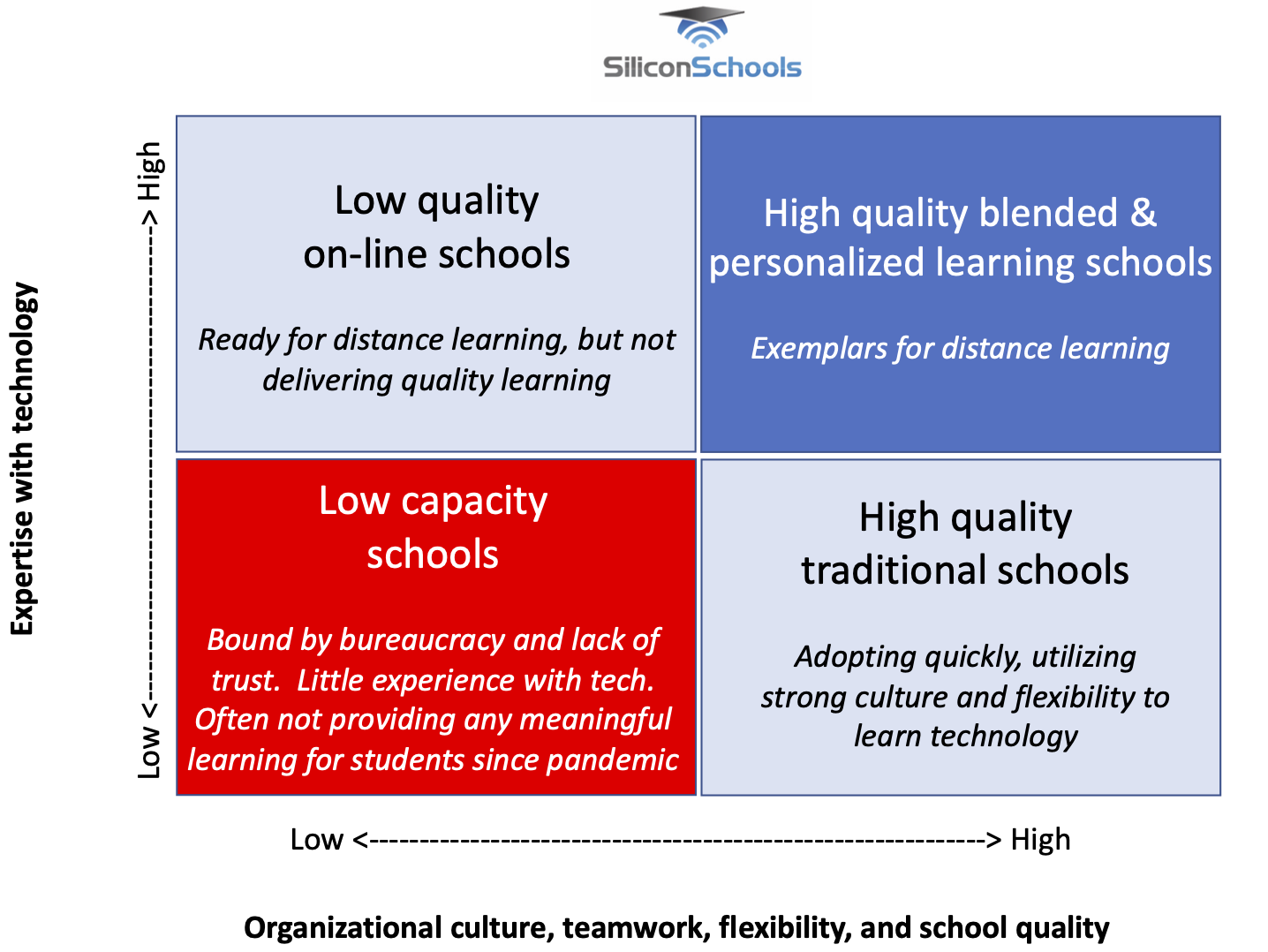
It’s almost summer, and our worldwide three-month experiment with distance learning comes to a close. Some schools and teachers have responded beautifully to this challenge. In other settings, virtually no learning has occurred at all. The Center on Reinventing Public Education recently conducted a national survey to capture data from across the county. It paints a powerful picture about how challenging distance learning has been.
• Districts rolled out distance learning plans slowly
• Only 20% of districts report using a system to track attendance
• 33% of districts surveyed, serving hundreds of thousands of students in some of America’s largest cities, do not set consistent expectations for teachers to provide meaningful remote instruction
• Only 16% of districts expect teachers to give meaningful feedback to students
We found the CRPE data compelling and wanted to know what it looked like for the schools we work with. Our foundation, the Silicon Schools Fund, has helped launch or transform over 50 schools across Northern California in many of the highest need communities. We surveyed a sampling with many of the same questions as CRPE. The data from these schools paints a very different picture.
• Schools supported by Silicon Schools Fund transitioned to distance learning within the first or second week from closure
• 85% of the schools are taking attendance, with almost every school above 90% average daily attendance
• 100% are providing online instruction
• 96% of schools are providing meaningful feedback to students with 70% also providing formal grades
Why are some schools responding beautifully and some so ineffectively? You can predict the way schools responded to the COVID crisis based on two factors: (a) experience using technology and (b) the functionality and flexibility of their school culture.

The schools that are succeeding (top-right quadrant) are generally experienced with technology and have flexible, team-oriented cultures. For schools not in the top right-quadrant, it is proving far easier to get better at tech than it is to solve the problem of low-capacity culture. Learning a new way to deliver school is essentially not possible if teams don’t already know how to work together effectively.
Knowing that remote learning will likely continue next year (either full-time or for a portion of each week) what can we learn from the schools that are succeeding with distance learning? Here are five suggestions to make it work.
1. Balance Live Teaching and Flexible Learning
There are two competing factors with distance learning. On one hand, families want synchronous (live) teaching that will keep kids on a schedule and give them “in person” interactions with their teachers. On the other hand, families want flexibility to manage the complexity of working from home while supporting students, sharing devices, etc. Our most successful schools use a combination of the two approaches: 30-120 minutes of daily live instruction, and 90-180 minutes scheduled flexibly in the form of independent work, recorded lectures, office hours, or online learning software.
2. Get Better at Remote Teaching through Coaching and Observations
We have to figure out how best to bring the magic of great teaching to distance learning. In partnership with our schools, we sat in on distance learning classes; what we saw both inspired and worried us. When classrooms are rocking, distance learning can be remarkably engaging and effective. When distance learning is done poorly, it’s arguably not worth the effort. To get better, our best schools have embraced online teacher coaching and feedback. Principals regularly observe online classes and debrief with teachers after. Some principals are even using the private chat feature or simultaneous phone calls to provide real-time coaching. Teachers also need to see examples of great remote teaching. Most teachers are able to learn a lot from a little. Even recording and sharing 30-60 seconds clips of dynamic remote teaching can be a powerful tool for teachers to get new ideas and see models of what effective online classrooms look like.
3. Make Student Learning Active, Even if Via Computer
Perhaps the most striking takeaway from studying distance learning was how important it still is for students to be active in their learning. We watched an amazing kindergarten teacher helping her students learn to count to 20 and practice grouping strategies. Every time she asked a question, her students pulled out their whiteboards (the school had mailed them home) and diligently worked on their solutions, proudly holding them up to their camera. We saw teachers effectively use break-out rooms to send students into small group discussion and then pull back into the full classroom. In contrast, in classrooms where the teacher lectured or asked general questions to the class, a lot of students were disengaged. The good news is that many of the solutions that work well in traditional classrooms work well online – narrating the positive, aggressive monitoring, targeting questioning.
4. Don’t Make 3.7 Million Teachers Reinvent Alone
As the CRPE data highlights, too many teachers are being left alone trying to reinvent schooling by themselves. In the age of distance learning, it is possible to dramatically redesign the role of the teacher, but it requires leadership. Some of the best schools are leaning on their top teachers to deliver instruction to the entire grade level, with their other teachers supporting and working with students in small groups. There is a nascent but interesting experiment underway this summer where schools across the country are going to run a shared summer school. “Master Teachers” will lead instruction in the morning for all students in a grade level countrywide, followed by local partner teachers providing customization and small group support to the students they know in their own schools. The idea is specialization, where the best curriculum designers create the curriculum, the best master teachers deliver the content, and the partner teachers focus on the students they know, devoting their full attention to the quality of student work being produced. If that’s successful, I’d be much more hopeful for such a collective initiative in the fall than I would each classroom trying to design their own approach to distance learning alone.
5. Figure Out How to Build Relationships Remotely
Schools doing distance learning effectively have been leveraging the relationships and culture they built with students before school closed. Next fall has a unique challenge in that many of the remote teachers will not already know their students as they did when school went out in March. How will teachers build relationships with new students over the computer? Even more worrisome, what about the new kindergartners? Can you imagine having to start your experience with school either entirely online or with everyone wearing a mask and being kept six feet apart? The schools we respect most are thinking about creative approaches to this challenge, such as starting school at least a week early for new students, having parents come to school with kindergartners if conditions allow, or doing social-distance home visits to welcome new students and begin the bonding process. For older grades, some schools are considering looping to keep existing students and teachers together for another year.
Importantly, we also have to solve the issue of Internet connectivity and bandwidth. Sitting in on classes these past weeks, we can attest that low or no bandwidth is a virtually impossible obstacle for teachers to overcome and should be table stakes for any serious conversation about urgent priorities for education this fall. This is too long of a topic to tackle here, but it is a solvable problem.
It is safe to say that this fall is going to be one of the hardest school starts we have ever experienced no matter which re-opening scenario we end up with. Our hope is that we can collectively tackle some of these challenges so that every educator is not left alone to make a million different decisions, that we can keep student interests at the center while ensuring safe conditions for teachers, and that we use this crisis as an opportunity to think differently about some elements of how we have always done school.
We can’t allow students to have another year without learning – the consequences to our country’s future will be too dramatic, especially for our most disadvantaged students. And we can’t ask teachers to solve these problems alone. Collectively we need to really improve distance learning, and we have to figure it out by September.
Brian Greenberg is CEO of the Silicon Schools Fund.
Read more from Education Next on coronavirus and Covid-19.


